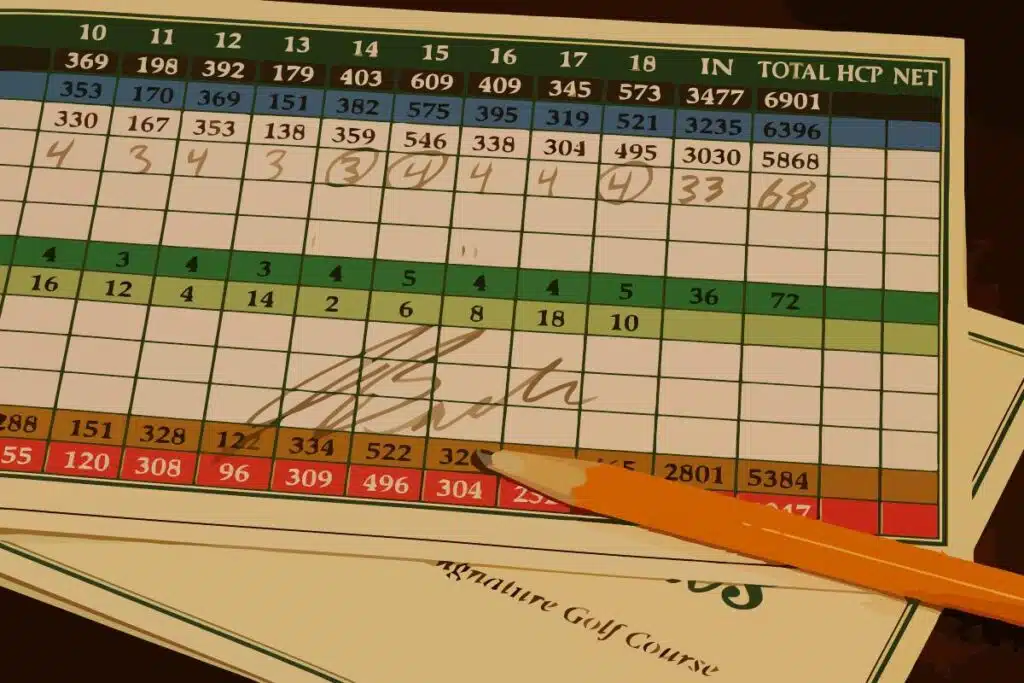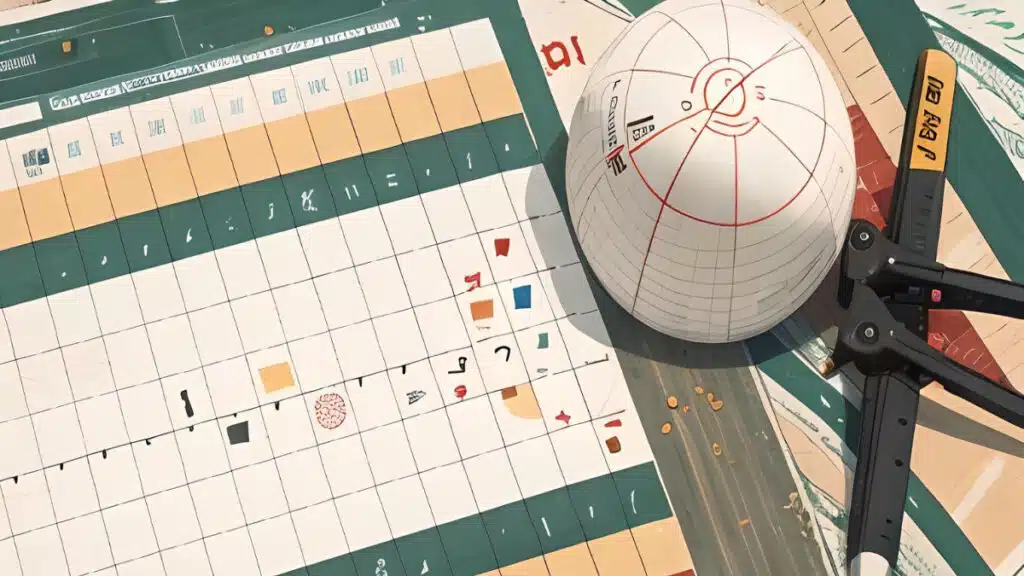If you’ve just started playing golf or are simply not familiar with the game, then it’s only natural to be so confused about how does golf scoring work.
In golf, whoever scores the lowest WINS, unlike what happens in the majority of sports around the world. So what’s that all about? Time to understand all about the popular golf scoring system!
In short, each individual hole on the golf course requires you to sink the ball into it with the least number of swings on your part – that’s the name of the game!
In This Post
Golf Scores – Meaning of Golf Scoring Lingo
Golf’s own language can be very confusing if you’re a newbie, almost like some foreign language altogether. So let’s cover basic ground in terms of the most commonly/popularly used golf scoring terms.
| Term | Definition |
|---|---|
| Ace/hole in one | Hitting the ball from the tee into the hole with a single stroke. |
| Albatross | Three strokes under par on a hole. Also known as a “double eagle”. |
| Birdie | One stroke under par on a hole. |
| Bogey | One stroke over par on a hole. |
| Condor | Four strokes under par on a hole. This is extremely rare. |
| Double Bogey | Two strokes over par on a hole. |
| Eagle | Two strokes under par on a hole. |
| Par | The predetermined number of strokes that a proficient golfer should require to complete a hole or a round. |
| Triple Bogey | Three strokes over par on a hole. |
| Fore | A warning shout when the ball is heading towards a person. |
| Mulligan | An informal term for a do-over or second chance to perform an action, usually due to a poor first effort. |
| Handicap | A system used to rate the skill level of players and even the playing field. |
| Stroke | The individual hits a golfer makes with the intent to strike the ball |
| Scratch Golfer | A golfer who can play to a Course Handicap of zero on any rated golf course. |

ACE
Hole-In-One – Meaning when you make the shot in a single stroke. Most likely to occur on par-3 because this hole is the shortest, distance-wise.
BIRDIE
1-Under Par – 1 stroke under par for a given hole is called a birdie, that’s the meaning of a birdie shot in golf.
EAGLE
2-Under Par – Eagle is a score of 2 strokes under par for a hole.
What is an eagle and how to score an eagle, both are very important to understand if you want to level up from being just an “average” golfer.
DOUBLE-EAGLE / ALBATROSS
3-Under Par – Just like eagle, albatross or double-eagle is also a very rare phenomenon on the golf course but this requires you to make the shot in just 2 strokes on par-5 and hole-in-one on par-4.
PAR
This is the expected score a good or expert player achieves for completing an individual hole. Understanding the par value of each hole is crucial since it directly tells you what you should be aiming for.
Par is determined by factors like distance as well as how difficult it is to play the hole. And the value assigned varies depending on the golf club used, along with aspects that influence the level of difficulty of that hole.
BOGEY
1-Over Par – Here the score is 1 stroke over par for any given hole. You achieve this by hitting your tee shot into a hazard.
DOUBLE-BOGEY
2-Over Par – Double-bogey is when you record 2 strokes over par for the hole. For example, when you hit into trouble, then fail to manage your way out of that trouble and make another bogey.
TRIPLE-BOGEY
3-Over Par – When you’ve hit a score of 3 strokes over par, that’s a triple-bogey!
For instance, you hit into off-the-tee trouble, fail to return from it and make another bogey (or you return a very poorly hit shot after trouble off the tee), which just creates yet another bogey.

How Does Golf Work In Terms of Scoring – Golf Scores With Relation to Par
Golf scoring terms are all based on the par value. And ‘par’ means the expected number of strokes a highly skilled golfer takes for completing every individual hole on the course. This means each hole features its own par rating. The most common ones include par-3, par-4, and par-5.
As for the average par on an 18-hole golf course, the total is 72. You add up the par values of all the 18 holes, which gives you a score in relation to par.
For example, your round of golf records 4-under par (with the total par of the course being 72),
then your score is 72 – 4 = 68.
Or if you shoot 2-over par (with the total par of the golf course being 70 this time),
then you’ve made 70 + 2 = 72
Golf Scoring System for Beginners – The Basics Where Every Swing Counts!
How to keep score in golf is actually a very simple thing to do. It only seems difficult, complex, and intimidating because you might not be acquainted with scorekeeping.
So here’s the deal – each golf swing of yours that gets the ball moving counts as a stroke. After each individual hole, that means after the golf ball has rolled or sunk into the hole cup, you add all the strokes you made for that hole. And that tally of strokes is the score you achieved for the hole.
For instance, on the first hole, you took 6 swings. So your score for that particular hole is 6. Then you made 4 swings on the second hole. And now your score has come to (6 + 4) 10. You keep going like this till you reach the end of your round. Scores are written down on your golf scorecard (each hole has its own row/column).
After the completion of your entire play on the golf course, add up all the scores of the individual holes you recorded to get the total score of your round of golf.
In the simplest of words, your golf scores refer to precisely how many times you whacked the golf ball around on that course!

The Different Formats of Golf Scoring
When golfing, to keep score against opponents or golfing buddies, these are the 3 most commonly used formats…
1. Stroke Play
Exactly what I’ve described in this article so far is stroke play where you take down how many strokes per hole you make and then tally those strokes of every individual hole at the end of your round. Whoever has the lowest score wins the game.
2. Match Play
The number of strokes per hole is recorded in this one too but the difference is that you compare your total strokes of each hole to those of your opponent’s.
Whoever gets the lowest score for that particular hole wins the hole. And then the winner in the end with the most number of hole wins is the winner of the match or game or round of golf.
3. Stableford System
Yet another popular golf scoring system, Stableford scoring consists of the conversion of scores (with relation to par) into points. So it’s the total points in the end, instead of total strokes, that decide who the winner is.
What About Penalty Strokes In Golf?
In many circumstances, penalty strokes are also added to the scores of a golfer, especially beginners. These strokes are a result of when you hit into a water hazard or if your shot goes out of bounds. At such times then, you have to take another shot i.e. an extra stroke added to your score.
When the golf ball is not found during play, you’re supposed to return to the previous position for a re-hit. Thus, adding one extra stroke to the score.
As for professional play, there are many rules under which that additional stroke can be added. Such as talking to another golfer about which club they used for the shot, making contact between a bunker or hazard with your club prior to hitting, and more.
What Is A Good Score In Golf?
If you’re talking about PGA Tour players, that “good” score is any score under par for the golf course.
Among average or amateur golfers, a good or ‘respectable’ score is anything below 120 strokes. Although 90 strokes on the scorecard are acceptable as average on any typical 18-hole course.
Conclusion
In comparison to most sports, golf has a pretty eccentric scoring system. Because in golf, the lowest score is considered to be the best score. That just means fewer and fewer strokes or shots taken for a particular hole and in the entire round of golf.
Every hole on the golf course has its own par value or rating, which represents the expected score for that hole. With that logic then, each course has its total par score (72 being the most common for 18 holes). It’s as simple as that, really!

